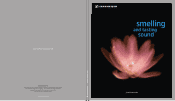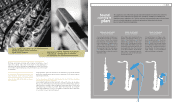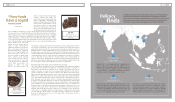Sennheiser 2009 Annual Report Download - page 7
Download and view the complete annual report
Please find page 7 of the 2009 Sennheiser annual report below. You can navigate through the pages in the report by either clicking on the pages listed below, or by using the keyword search tool below to find specific information within the annual report.
12 SOUND
How important is the interplay between microphone and mouthpiece?
The mouthpiece is a very important part of playing a wind instrument. But so is its bamboo
reed. There has to be a synergy between the reed, mouthpiece and instrument. Couple that
with the right microphone, a room with great acoustics, a good audience and the right
music, then nothing can go wrong (laughs).
You are a trained sound engineer and have your own studio …
That’s true. But what I learned in the 1960s no longer applies today. That is, other than
a natural curiosity in technology. Actually, I learned the most about sound technology in the
late 1970s, when I set up my own studio. I had a room that we used for recording –
sometimes even with two microphones. In other words, we started out very, very small.
Today’s music software is making a lot of studio
equipment obsolete. Would it be fair to say that
all you need today is a fast computer and good
microphones?
It’s not as though analog technology has to be thrown
out completely. The microphone connects the artist with
the recording equipment. The microphones you use
make all the difference, especially when recording
expressive things like the voice and other instruments.
Now that you work with software, do you miss analog devices?
With buttons to rotate, they could be very sensual.
Recording has become less complicated. In the past, I was a prisoner
to the studio as well as the sound engineer and his assistants. Today,
I can do it all myself. Digital technology has its own sensuality;
for instance, clicking on a mouse to achieve the effects I want.
I have always considered sound technology as a natural extension of
my musicianship.
You use Sennheiser microphones both on stage and in your
studio. What do you like about them?
EW-500 wireless microphones give me freedom of movement. How-
ever, when it comes to acoustic improvisation with jazz piano and
bass accompanied by the discreet rhythm of the drums, I prefer a
stand microphone so that I can increase or lower the dynamics by
moving toward or away from the mic. When I record myself, there’s
nothing better than the tried and true Neumann microphones.
“The microphone makes a huge
difference, especially when
recording sensitive sounds
like the human voice or
certain instruments.“
I had a lot of role models – “Diz zy” Gillepsie,
Miles Davis, Lester Young. But, in the end,
it all comes down to finding my own voice.




















